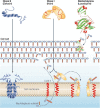Impact of genomics on the field of probiotic research: historical perspectives to modern paradigms
- PMID: 24748373
- PMCID: PMC4064118
- DOI: 10.1007/s10482-014-0171-y
Impact of genomics on the field of probiotic research: historical perspectives to modern paradigms
Abstract
For thousands of years, humans have safely consumed microorganisms through fermented foods. Many of these bacteria are considered probiotics, which act through diverse mechanisms to confer a health benefit to the host. However, it was not until the availability of whole-genome sequencing and the era of genomics that mechanisms of probiotic efficacy could be discovered. In this review, we explore the history of the probiotic concept and the current standard of integrated genomic techniques to discern the complex, beneficial relationships between probiotic microbes and their hosts.
Figures





Similar articles
-
The life history of Lactobacillus acidophilus as a probiotic: a tale of revisionary taxonomy, misidentification and commercial success.FEMS Microbiol Lett. 2013 Dec;349(2):77-87. doi: 10.1111/1574-6968.12293. Epub 2013 Oct 24. FEMS Microbiol Lett. 2013. PMID: 24152174
-
The history of probiotics: the untold story.Benef Microbes. 2015;6(2):159-65. doi: 10.3920/BM2014.0103. Benef Microbes. 2015. PMID: 25576593 Review.
-
History of Antibiotics Research.Curr Top Microbiol Immunol. 2016;398:237-272. doi: 10.1007/82_2016_499. Curr Top Microbiol Immunol. 2016. PMID: 27738915 Review.
-
Epigenetics: A New Frontier in Probiotic Research.Trends Microbiol. 2021 Feb;29(2):117-126. doi: 10.1016/j.tim.2020.04.008. Epub 2020 May 11. Trends Microbiol. 2021. PMID: 32409146 Review.
-
Dr. Robert Roberts oversees special issue on genomic medicine for the Methodist DeBakey Cardiovascular Journal.Methodist Debakey Cardiovasc J. 2014 Jan-Mar;10(1):1. Methodist Debakey Cardiovasc J. 2014. PMID: 24932353 Free PMC article. No abstract available.
Cited by
-
Revealing the combined effects of lactulose and probiotic enterococci on the swine faecal microbiota using 454 pyrosequencing.Microb Biotechnol. 2016 Jul;9(4):486-95. doi: 10.1111/1751-7915.12370. Epub 2016 Jun 16. Microb Biotechnol. 2016. PMID: 27305897 Free PMC article.
-
In vitro and in vivo evidences for innate immune stimulators lactic acid bacterial starters isolated from fermented camel dairy products.Sci Rep. 2018 Aug 22;8(1):12553. doi: 10.1038/s41598-018-31006-3. Sci Rep. 2018. PMID: 30135492 Free PMC article.
-
Use of Wild Type or Recombinant Lactic Acid Bacteria as an Alternative Treatment for Gastrointestinal Inflammatory Diseases: A Focus on Inflammatory Bowel Diseases and Mucositis.Front Microbiol. 2017 May 9;8:800. doi: 10.3389/fmicb.2017.00800. eCollection 2017. Front Microbiol. 2017. PMID: 28536562 Free PMC article. Review.
-
Functional genomics of lactic acid bacteria: from food to health.Microb Cell Fact. 2014 Aug 29;13 Suppl 1(Suppl 1):S8. doi: 10.1186/1475-2859-13-S1-S8. Epub 2014 Aug 29. Microb Cell Fact. 2014. PMID: 25186768 Free PMC article. Review.
-
AcmB Is an S-Layer-Associated β-N-Acetylglucosaminidase and Functional Autolysin in Lactobacillus acidophilus NCFM.Appl Environ Microbiol. 2016 Aug 30;82(18):5687-97. doi: 10.1128/AEM.02025-16. Print 2016 Sep 15. Appl Environ Microbiol. 2016. PMID: 27422832 Free PMC article.
References
-
- Altermann E, Russell WM, Azcarate-Peril MA, Barrangou R, Buck BL, McAuliffe O, Souther N, Dobson A, Duong T, Callanan M, Lick S, Hamrick A, Cano R, Klaenhammer TR. Complete genome sequence of the probiotic lactic acid bacterium Lactobacillus acidophilus NCFM. Proc Natl Acad Sci USA. 2005;102(11):3906–3912. - PMC - PubMed
-
- Antikainen J, Anton L, Sillanpaa J, Korhonen TK. Domains in the S-layer protein CbsA of Lactobacillus crispatus involved in adherence to collagens, laminin and lipoteichoic acids and in self-assembly. Mol Microbiol. 2002;46(2):381–394. - PubMed
-
- Ataie-Jafari A, Larijani B, Alavi-Majd H, Tahbaz F. Cholesterol-lowering effect of probiotic yogurt in comparison with ordinary yogurt in mildly to moderately hypercholesterolemic subjects. Ann Nutr Metab. 2009;54(1):22–27. - PubMed
Publication types
MeSH terms
Substances
LinkOut - more resources
Full Text Sources
Other Literature Sources
Molecular Biology Databases

